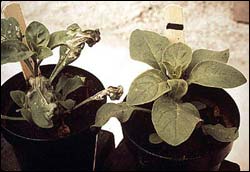Boosting Vitamin C in Plants Can Help Reduce Smog Damage

Ozone-damaged plant (left) and normal plant (right). Photo courtesy of Gene Daniels/U.S. EPA
UCR research shows boosting plant vitamin C levels can minimize ozone’s damaging effects
The harmful effects of smog on people and animals – the stinging eyes and decreased lung capacity – are the stuff of well-researched fact. Now, the body of knowledge about air pollution’s effects on plants has grown with University of California, Riverside Biochemistry Professor Daniel Gallie’s discovery of the importance of vitamin C in helping plants defend themselves against the ravages of ozone – smog’s particularly nasty component.
By manipulating dehydroascorbate reductase (DHAR), a naturally occurring enzyme that recycles vitamin C, to increase the level of the vitamin in leaves, Gallie has been able to reduce the harmful effects of ozone on plants, apparent as brown spots, stunted size, and lowered crop yields. He and Assistant Research Biochemist Dr. Zhong Chen published their findings in a recent paper titled Increasing Tolerance to Ozone by Elevating Foliar Ascorbic Acid Confers Greater Protection Against Ozone Than Increasing Avoidance, in the journal “Plant Physiology.”
Gallie’s previous research found that plants react to smog much like they react to drought, by closing pores (called stomata) present in their leaves. The closed pores protect plants from losing water and taking in ozone, but also prevent the production of sugars through photosynthesis, which are needed for the plant to grow.
“It’s clearly not an effective strategy to protect plants from the effects of long-term exposure to smog,” Gallie said.
Plants, he said, have two options to defend themselves from ozone. They can prevent ozone from entering the leaf by closing their stomata, or use the antioxidant qualities of vitamin C to detoxify the ozone that enters through open stomata and also protect the photosynthetic machinery in the leaf.
Studying acute and chronic ozone exposures, Gallie and Chen looked at which plants fared better, those with lower levels of vitamin C that closed their pores or those with higher levels of vitamin C, open pores, and higher levels of photosynthetic activity. Those with the higher levels of vitamin C fared better in the long run, in both instances, despite the fact that more ozone entered through the open pores of the leaf, Gallie said.
Gallie and Chen’s findings offer a clear direction for a strategy toward developing plants that will be able to grow and thrive in high-ozone environments such as cities and suburban areas.
“Because we’re seeing, especially in this country, the encroachment of urban areas into farm lands, we’re seeing an increased impact on agriculture. Moreover, ornamental plants used for urban and suburban landscaping are heavily affected by exposure to smog,” said Gallie.
The next step in Gallie’s research will focus on the apparent correlation between a plant’s increased vitamin C levels and increased photosynthetic activity.
“There seems to be multiple benefits of increasing the level of vitamin C in plants, including improving their tolerance to smog, improving photosynthesis, and improving their nutritional quality but more research is clearly needed,” he said.
The key question, at least in the near term, is to determine whether increased vitamin C and photosynthesis will result in greater crop yields, he added.
Media Contact
More Information:
http://www.ucr.eduAll latest news from the category: Ecology, The Environment and Conservation
This complex theme deals primarily with interactions between organisms and the environmental factors that impact them, but to a greater extent between individual inanimate environmental factors.
innovations-report offers informative reports and articles on topics such as climate protection, landscape conservation, ecological systems, wildlife and nature parks and ecosystem efficiency and balance.
Newest articles

Silicon Carbide Innovation Alliance to drive industrial-scale semiconductor work
Known for its ability to withstand extreme environments and high voltages, silicon carbide (SiC) is a semiconducting material made up of silicon and carbon atoms arranged into crystals that is…

New SPECT/CT technique shows impressive biomarker identification
…offers increased access for prostate cancer patients. A novel SPECT/CT acquisition method can accurately detect radiopharmaceutical biodistribution in a convenient manner for prostate cancer patients, opening the door for more…

How 3D printers can give robots a soft touch
Soft skin coverings and touch sensors have emerged as a promising feature for robots that are both safer and more intuitive for human interaction, but they are expensive and difficult…





















